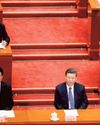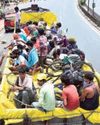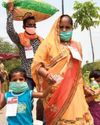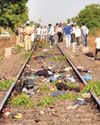The legal challenge to Article 35A, which protects the demographic composition of Jammu and Kashmir, has brought all sides of the political spectrum, barring the BJP, together. Tampering with it has the potential of setting the Valley ablaze once again.

A SEMBLANCE of normalcy seemed to be returning to Jammu and Kashmir this year, despite intermittent lapses into violence such as the skirmishes that claimed nine lives on April 9, the day when elections were held for the Srinagar parliamentary seat. But if things appeared to be settling down, a new issue has cropped up to agitate emotions: that of Article 35A.
The unrest of 2016, besides leaving nearly 100 people dead, thousands wounded and many people blinded as a result of pellet injuries, had badly hit the State’s economy and education. Tourism, which too continues to feel the impact, touched its lowest ebb this year.
The coalition government led by Chief Minister Mehbooba Mufti has been in the thick of fighting new-age militancy as the number of local youths joining the ranks of militants swelled up alarmingly. The Valley was rocked by agitations in 2008,2010 and again in 2016. Now, it seems ready for another battle as the people fear that Article 35A, which has been challenged in court, must be saved and that its possible abrogation will have dangerous consequences for the Valley. The perceived threat to Article 35A has not only brought together arch rivals in the State’s mainstream political parties but made separatists join the bandwagon of saving Article 35A “at any cost”.
Denne historien er fra September 15, 2017-utgaven av FRONTLINE.
Start din 7-dagers gratis prøveperiode på Magzter GOLD for å få tilgang til tusenvis av utvalgte premiumhistorier og 9000+ magasiner og aviser.
Allerede abonnent ? Logg på
Denne historien er fra September 15, 2017-utgaven av FRONTLINE.
Start din 7-dagers gratis prøveperiode på Magzter GOLD for å få tilgang til tusenvis av utvalgte premiumhistorier og 9000+ magasiner og aviser.
Allerede abonnent? Logg på

How Not To Handle An Epidemic
The lockdowns were meant to buy time to put in place appropriate health measures and contain the coronavirus’ spread, but they have failed to achieve the objective and heaped immense misery on the marginalised sections of society. India is still in the exponential phase of the COVID-19 infection and community transmission is a reality that the government refuses to accept.

Tragedy on foot
As the COVID-19-induced lockdown cuts the ground beneath their feet in Tamil Nadu, thousands of migrant workers are trudging along the highway to the relative safety of their upcountry homes.

Sarpanchs as game changers
Odisha manages to keep COVID-19 well under control because of the strong participation of panchayati raj institutions and the community at the grass-roots level under the leadership of Chief Minister Naveen Patnaik.

Scapegoating China
As the COVID-19 death rate spikes and the economy tanks in the United States, Donald Trump and his advisers target China and the World Health Organisation with an eye to winning the forthcoming presidential election.

New worries
Kerala’s measured approach to the pandemic and lockdown has yielded results. But it still has to grapple with their huge economic impact on its economy, which it feels the Centre’s special financial relief package does little to alleviate.
No love lost for labour
Taking advantage of the lockdown and the inability of workers to organise protests, many State governments introduce sweeping changes to labour laws to the detriment of workers on the pretext of reviving production and boosting the economy.

Capital's Malthusian moment
In a world that needs substantial reorienting of production and distribution, Indian capital is resorting to a militant form of moribund neoliberalism to overcome its current crisis. In this pursuit of profit, it is ready and willing to throw into mortal peril millions whom it adjudicates as not worth their means—an admixture of social Darwinism born of capital’s avarice and brutalism spawned by Hindutva. .

Understanding migration
When governments and their plans are found to be blatantly wanting in addressing reverse migration, exercises such as the Ekta Parishad’s survey of migrant workers throughout India can be useful to work out creative long-lasting solutions.

Waiting for Jabalpur moment
The Supreme Court’s role in ensuring executive accountability during the ongoing lockdown leaves much to be desired. Standing in shining contrast is the record of some High Courts.

An empty package
The Modi regime, which has been unable to control the COVID-19 infection, restore economic activity and provide relief to millions exposed to starvation, trains its sights on Indian democracy, making use of the panic generated by fear and a lockdown that forecloses paths of resistance.